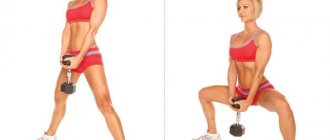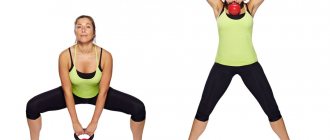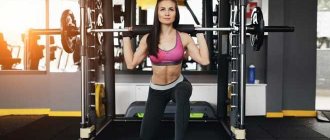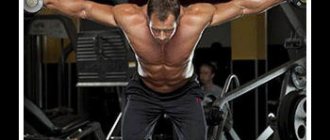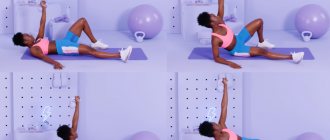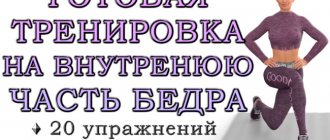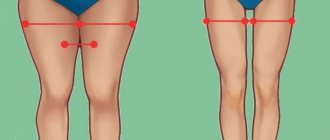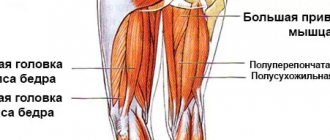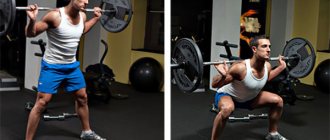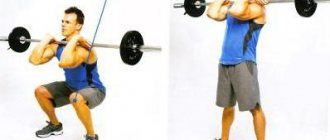Goblet squats, goblet benefits and technique
Kettlebell squats, also known as goblet squats, or goblet squats, are an excellent exercise for developing the muscles of the thighs and buttocks. This type of squats is technically simpler than barbell squats and is quite suitable for training beginner athletes. For those who are interested in kettlebell fitness, this exercise is, one might say, an element of a mandatory program. Let's look at performing this type of squats in more detail.
What does the exercise do?
Like other types of squats, kettlebell squats develop the muscles of the lower body. First of all, these are the quadriceps (front of the thigh). The gluteus maximus muscles also work. Additional stress is experienced by the muscle group of the posterior thigh, calf muscles, and lower back. Due to the fact that you hold a weight in your hands, your biceps and shoulders experience static tension. In other words, the array of muscle groups involved is quite large.
Performing goblet squats effectively works the muscles of the legs and buttocks.
In addition to training the hips and buttocks, the exercise has the following positive effects:
To perform the exercise correctly, you will need to work on hip mobility and flexibility and lower back stability.
The ability not to twist the tailbone forward when performing squats is an important quality for an athlete. A large range of motion gives a good stretch to the muscles of the thighs and buttocks. And the more a muscle stretches before it contracts, the more effective its training. Improving blood circulation in the pelvic organs, preventing congestion.
Please note that if you have not previously been involved in fitness, and the muscles of your legs, buttocks and back are not sufficiently developed, when performing deep squats, you expose significant stress to the knee ligaments, which can lead to injury. Therefore, if you are just starting your training, limit yourself to regular squats until your thighs are parallel to the floor.
Also, people with lower back pain should not tempt fate. Otherwise, goblet squats are a fairly safe exercise, provided you follow the technique.
How to do the exercise?
Now, let’s actually move on to the technique of doing squats with a kettlebell.
- Stand up straight, place your feet slightly wider than your shoulders, and turn your toes slightly outward. You can either immediately pick up the kettlebell by the handle, or place it in front of you and lift it during your first squat. It's more convenient to take it right away. The weight should be held in bent arms at chest level, close to the body.
- As you exhale, maintaining a straight back position (natural arch in the lower back), perform a squat. How far to lower your pelvis in this exercise depends on your flexibility and fitness. If you are an experienced athlete and can squat under control (not fall) below the parallel of your thighs with the floor, while keeping your back straight and not twisting your tailbone forward, squat deeply. If your physical fitness does not allow this, squat to parallel. Watch the sensations in your knees. The elbows are directed downwards when performing the movement. In the case of a deep squat, they pass between the knees.
- As you exhale, rest your heels on the floor and rise to the starting position. Make sure your knees don't roll inward as you lift.
Perform this exercise 10-15 times in 3-4 sets, unless otherwise indicated in your training program. Take the maximum weight of the kettlebell at which you can maintain balance and maintain the correct technique.
Useful tips
Below is a list of points that you should pay attention to in order to ensure that your training is as effective and safe as possible:
- While squatting, watch the direction of your knees. It should coincide with the direction of the toes.
- Do not allow your buttocks to curl forward. Try to keep your back straight and move your tailbone back as much as possible.
- When you rise from a squat, there is always a temptation to lift your pelvis first and then your shoulders. This is not done correctly. The back should be straight, and the body should not fall forward.
- By lowering your elbows between your legs at the bottom of the movement, you can apply a little pressure to the inside of your legs. This will allow you to spread your knees wider.
- Instead of a kettlebell, you can use a dumbbell, holding it by one of the plates.
What muscles are involved?
Kettlebell squats, like other types of squats, are used to pump up the lower body. The exercise is classified as basic - it involves several large muscle groups. The main work here is performed by the quadriceps of the thigh, and the gluteal muscles receive a secondary load.
Additionally, the muscles of the back of the thigh, lumbar back, and calf muscles are involved in the movement. The biceps, shoulders and forearms receive static load.
Although this exercise involves less muscle volume than a classic squat, goblet squats are considered a safer option.
The harm of squats
The benefits of squats with kettlebells are undeniable. But sometimes this exercise can be harmful. For example, if you have medical contraindications to putting stress on your knee joints, back, or other parts of the body responsible for distributing the load when squatting, you should consult a specialist. You may have to give up this exercise altogether or choose the optimal load to avoid injury. And of course, if the technique is violated, the harm to joints and muscles is simply colossal. Incorrect distribution of the load, sharp shocks or jerks can reward you with any type of damage: from sprains and dislocations to serious fractures. That is why it is better to practice the squatting technique under the supervision of an instructor.
Benefits of squats
In addition to the direct benefits, squats with a kettlebell for the buttocks have other advantages. First of all, it is worth noting the improvement in general physical fitness. After all, during this exercise, almost all muscles work, including the abs. Doing squats every day will help work out problem areas, improve endurance and strength. It will give you vigor. Even if you perform the exercise without weights, there will be an effect. The main thing is to get the technique right, and then use squats with two kettlebells or one, as you like. Interestingly enough, weighted squats affect hormonal levels. They promote the production of testosterone, the muscle growth hormone.
Squats with kettlebells targeting the quadriceps
Kettlebell squats are a basic strength exercise, the main load of which falls on the quadriceps femoris muscle (quadriceps). Additional load falls on the calf and gluteal muscles. As you can see, squats with kettlebells are a compound exercise that involves several muscle groups at once.
Kettlebell front squats, also called front squats, are quite challenging. Correct execution of the exercise requires good concentration, physical training experience and proper technique. This version of squats with weights involves holding two weights on your shoulders in front of you as much as possible, without lowering the weights below your chest.
Benefits of Kettlebell Squats
Squats with kettlebells allow you to increase the strength and mass of the muscles of the thighs and buttocks.
In addition, the exercise has such advantages as developing the overall strength of the athlete and improving performance in other heavy basic exercises. Many muscle groups of the body are involved in the process of this movement.
By regularly performing squats with kettlebells, you can pump up your target muscles, increase your strength and endurance. Exercise will bring overall tone to the body.
Beginner athletes are advised to first master the correct technique. Take your time, work with your own body weight, feel the load and muscle contraction, and then gradually increase the weight of the apparatus.
What muscles are involved?
The exercise will be very effective for girls who want to have beautiful and toned hips and buttocks. The mechanics of the movement allow you to do squats very deeply, while the gluteal muscles will be actively involved. However, also keep in mind that the gluteal muscles, in turn, as a group of muscles are divided into three separate muscles: the gluteus maximus, the gluteus medius and the gluteus minimus.
In addition to the buttocks, squats with kettlebells engage the core stabilizing muscles, such as the abdominal muscles and lumbar back muscles. The calf muscles also work.
While holding weights on the chest or shoulders, the muscles of the arms (biceps, anterior deltoids) and forearms experience static load.
Technique for performing the squat exercise with kettlebells
The technique of performing squats with kettlebells requires knowledge of some features and nuances. Following strict technique allows you to get good results from this movement in a short time.
- Lift two weights onto your shoulders. Extending your knee and hip joints, place the weights on your shoulders. Rotate your wrists inward so the weights rest comfortably on your shoulders.
- Looking straight ahead throughout the exercise, squat down as low as you can and pause at the bottom of the range of motion. As you lower down, spread your knees out to the sides. You should squat, spreading your legs outward, keeping your torso upright, head and chest straight and slightly up.
- Rise back up, focusing on your heels, and repeat the movement.
- Repeat for the recommended number of reps.
Execution Features
Always stretch before performing squats. Also, in order to warm up the muscles, you can walk along the path in an intense manner for about 5-10 minutes; The back is straight throughout the entire approach, there is a slight deflection in the lower back; Watch the position of your knees, which should not go beyond your toes and move in the direction of your feet. Do not use inertia when going down and going up, do not swing your body, make the movement without using jerks; Keep your abdominal and lower back muscles tense. When the exercise is performed correctly, a certain load is also placed on these muscles. Exhale while going up, exhale while going down. Breathing is smooth and measured; Due to the mechanics of the exercise, squats with kettlebells can be classified as front squats, therefore the emphasis of the load falls on the quadriceps of the thighs
You should pay attention to this; we recommend including the squat exercise with kettlebells in your training program.
Options:
It is possible to use two dumbbells instead of two weights when performing the exercise.
Video on squats with kettlebells
This is interesting: Hack squats - we are considering the issue
Plie
What muscles work?
Plie squats are a multi-joint exercise that develops strength in all the major muscles in the lower body.
- The gluteus maximus controls the movement of your hips as you lower and rise.
- The quadriceps (the muscles on the front of the thigh) move the knees.
- The calves control movement in the ankle joints.
- The core muscles allow you to keep your back straight throughout the entire movement.
- The muscles of the inner thigh (adductors/adductors) take the most active part and receive a powerful “conditionally isolated” load.
Result: pros and cons
What they give:
- The main difference between this type of wide squats and others is the additional load on the adductor muscles of the thigh, our traditionally problematic female area - the inner thigh. By the way, an additional exercise for the development of these particular muscles is the abduction and extension of the legs in a sitting machine . In addition, the gluteus maximus, medius and minimus muscles receive load. Those. There is a comprehensive study of the muscles of the legs, hips and buttocks.
- This exercise is excellent for developing flexibility of the hip joints , which is, in principle, very important for a high-quality and deep squat. So if you have any difficulties doing squats, then feel free to include plie squats in your training program!
- Improved blood circulation in the lower body . This affects both the condition of the skin and the health of the pelvic organs.
- Variability . You can do wide leg squats with a barbell, dumbbells at your feet, kettlebell, bag, etc. These are great for leg training at home.
Harm:
- The technique of performing the exercise is more complex than classic squats. To properly do a wide squat without bringing your knees inward, you need at least basic physical training.
- Load on knee and hip joints , which are not in the most usual position. In ordinary life, we usually don’t have to squat with our legs wide apart.
Technique: how to do it right
This exercise seems easy only at first glance; ladies often make mistakes that negate all the positive effects of its implementation. So, we must admit that it is almost impossible to perform it with a barbell, which means we will study the technique of performing it with dumbbells and kettlebells for girls and men (the rules are the same for everyone):
- Stand up straight, statically tense your abs and pick up a dumbbell with an overhand grip on the weight plate (at the base). Place your feet wider than your shoulders, bend your knees slightly and spread your feet outward (to about a 45-degree ). Place a dumbbell or kettlebell between your legs. This is your starting position.
- As you inhale, begin to pull yourself down, slowly bending your knees. In the hip and knee joints you will experience bending. Lower yourself until your hips are parallel floor and if stretching is allowed, then lower. Take your time.
In the negative phase (when you sit down), the speed of the squat should be slow (time guide is 3-4 seconds). Afterwards, do not get up immediately, you will feel a good stretch of the adductor muscles, only after that, as you exhale, bring your body into the IP, pushing your heel off the floor. Repeat the specified number of times.
Please note: the knees should not come together , but should go to the sides (work like scissors), the body should be in a strictly vertical position . There is no need to try to “retract” your butt. It is better to stand sideways to the mirror and look at your buttocks; they should not lean back too much or “protrude” forward.
Correct execution should cause a burning sensation in the quadriceps, inner thighs and buttocks.
The most important point is the depth of the squat. Remember, the lower you go, the more your glutes and hamstrings will work . However, be careful and watch your knees - if you feel discomfort in them, then you should slow down. For greater depth of squat and accentuated development of the buttocks, you can use step platforms under each of the legs.
Please also note that you should not fully straighten your knees . This determines whether the knee joints will receive excessive load.
Bone Broad does not recommend doing the plie style in Smith or with a barbell: it will be very difficult even for a very well-coordinated person. The safest and most convenient option is with elastic bands:
Main nuances
- throughout the entire movement, keep your back straight and the apparatus close to your body. Throughout the entire exercise, your back should be arched at the lower back. Under no circumstances should you round it . In order for your back to be straight, it is important to look forward and slightly upward, as if at a person who is a head taller than you. Don't raise your head too much or lower it too much - this will cause you to lose your balance;
- It’s better to turn sideways to the mirror and record each stage;
- do the exercise smoothly and without jerking ;
- turning the feet at 45 degrees is purely conditional; the feet should be placed as far as the flexibility of the body allows without violating the technique, so that you feel comfortable ;
- inhalation is performed in the eccentric part of the movement, exhalation is performed with effort;
- arms should be stationary in this exercise and should not “walk”;
- knees should not extend beyond the feet;
- if you have difficulty maintaining balance, then perform plie squats with your back against the wall ;
- the knees should not come together, but should go to the sides (work like scissors);
- warm-up before it ;
- weights and pancakes as weights ;
- at the top of the movement, do not block/lock your knees;
- You can supplement each repetition with calf raises to work your calf muscles.
Kettlebell squats SportWiki encyclopedia
Squats facing the wall
This exercise is taken from John Du Kane's book, The Qigong Recharge. Chinese wall squats are an excellent exercise for developing the back and hip joints, which are absolutely necessary for deadlifts and squats.
Kettlebell Squats
Stand facing the wall a few centimeters away from it, feet slightly wider than shoulder-width apart, and keep your arms free. Press your feet firmly into the floor, the outer sides of your feet should not lift, do not frog your knees outward, squat down as far as you can.
You will notice that you cannot go below a certain point without expanding your chest and arching your lower back. If you try to prove me wrong and continue to sink down, your forehead and knees will hit the wall and you will have to move away from it.
Move slowly and carefully, use force. When your legs or back get tired, stop, shake to relieve tension and do the exercise over and over again.
You will get more benefit from the exercise if you do it several times throughout the day, every day.
Continue practicing the movement until you reach a half squat. Once you've mastered it, move a little closer to the wall and continue practicing. The goal is that with your toes touching the wall, you can squat low enough to grasp the kettlebell.
Kettlebell Squat
Great for strength training and mastering proper lifting technique.
- Weight under the chest. Hands grip the weight like a steering wheel. Arms from shoulder to elbow are perpendicular to the floor, legs are spaced slightly wider than shoulders. The back is straight.
- Now squat until your thighs are parallel to the floor. The body leans forward. Then return to the starting position.
TIP: Don't lean forward too much. The feet remain on the floor, the heels never leave the floor. The toes remain in line with the knees.
Overhead Kettlebell Squat
Develops flexibility, strength and endurance of the back and legs.
- Hold the kettlebell at your shoulder so that it rests on the crook of your elbow. Spread your legs slightly wider than your shoulders.
- Squat down slightly.
- Stand up quickly, lifting the weight above your head.
- Do a squat without lowering the weight. Move your free hand to the side. Then stand up again. For the second approach, switch hands.
TIP: Feet should not leave the floor. To start, grab a light weight so that you can position it above you accurately.
Turkish squats with kettlebell (from bottom to top)
Arm strength meets core strength.
- Lie on your back. The left leg is straightened, the right arm is abducted at an angle of 45 degrees. The right leg is bent. Grasp the projectile, holding it with the handle down. The right hand lifts the projectile towards the ceiling.
- Lift the projectile and reach for it with your head and body. The left elbow rests on the floor.
- Shift the emphasis from the elbow to the hand. Straighten your body. Raise your pelvis. The left hand comes off the floor.
- Straighten your knees, place your feet next to each other. Performing movements in reverse order, return to the starting position.
TIP: For the first series of exercises, work with light weights. In addition, most of the time the gaze should be directed at the projectile - the exception is in Fig. 4
Basic exercises
A kettlebell deadlift is essentially a squat. The exercise can be a simpler replacement for the barbell row because it does not require complex skills from the athlete. The athlete squats and grabs the kettlebell handle with both hands, and then stands up, straightening his legs. When squats, the projectile lowers and rises almost vertically, passing between the knees.
The one-arm kettlebell row is performed in much the same way as the deadlift. The weight is taken in one hand and raised, while the other hand is moved to the side. Each repetition can be accompanied by a change of hands, or you can first perform several repetitions for the left and then for the right.
The sumo kettlebell row is performed with one or two kettlebells. The main difference with the deadlift is the wide stance of the legs, the feet of which are turned to the sides. The exercise effectively engages the inner thigh.
Front squats with two kettlebells are done like this: the athlete sits up slightly and takes the kettlebells in each hand by the handles. Then he throws them so that each weight is comfortably placed between the pectoral muscle and the biceps of the arm in which it is located, and the handles are parallel to each other. After this, the athlete can align the handles to make it more comfortable and begin performing squats.
Front squats with one kettlebell are performed in much the same way. The kettlebell is placed next to the pectoral muscle and biceps, and the athlete supports it by the handle with the same hand. After this, squats are performed, during which the athlete must maintain a straight back position. The exercise is effective for developing balance.
Goblet or “goblet” squats are so called because the weight rests in the hands like a goblet. The grip can be different, and the kettlebell can be turned with the handle down or up, the main thing is that the projectile is placed under the chin at a short distance from the chest. This exercise is simpler than barbell squats, but it is very effective for developing the muscles of the buttocks and thighs, as well as mobilizing the joints, so it is often included in complexes for beginners.
“Gourmets” of kettlebell lifting also perform goblet squats, holding the kettlebell by the convex places, and not by the handle, which allows them to train their hands.
Overhead squats with two kettlebells are a very effective exercise for not only strengthening your muscles, but also mobilizing your shoulders and back. In order to perform it, the athlete takes weights in two hands, lifts them above his head and squats without lowering the weights.
The single kettlebell overhead squat is a more challenging exercise. To understand how to properly squat with a kettlebell in one hand, you need to try it: shifting the load will force you to distribute your body weight differently. In this case, you need to think about how the squat has approximately the same effect on both legs.
Necessary equipment
The exercise is very variable - it’s not for nothing that it’s called “squats with a weight between the legs.” Depending on what kind of weight it is and what additional devices are used, the exercise technique can vary greatly.
Most often it is performed with a kettlebell or dumbbell between the legs . But in this case, the back also works, and it’s problematic to lift a lot of weight, if only because it’s hard to hold a large dumbbell. Of course, you can use belt straps, but it’s still not very comfortable.
There is an option in which the weight is attached to a special belt on ropes or chains (this is often done for pull-ups with weights). Then the back is unloaded, only the legs swing, and the arms lie calmly, usually on the shoulders.
Finally, another option is when squats are performed with a T-bar (this is a pin, one end of which is fixed, and on the other there is a stop for hanging plates and handles to hold on to). Here you can hang as much as you like and far exceed a hundred kilograms. But again, the back is not completely switched off from work.
An advanced version of performing such squats is from plinths, that is, small elevations. Either special “bricks” are taken, or step platforms, or something else. The legs are placed on the plinths and squats from them, which allows you to significantly increase the amplitude of movement, and therefore the effectiveness of the exercise. Additionally, the muscles are stretched. But a person who does not have sufficient flexibility in the hip joint will not feel the benefits of squats from platform bars.
Who is suitable for front squats?
They can be practiced by athletes who have various spinal injuries; if you suffer from lumbar osteochondrosis, then standard squats are prohibited for you, because during work the spine is rounded. And the entire process of the front squat keeps your back straight, which is why we recommend it.
Tall athletes, who are not very comfortable squatting in the rack, because of this, cannot properly pump their legs. Front squats are ideal for them.
Adviсe
Few athletes pay due attention to shoes, and this is very important. When performing front squats, you need good shoes to perform well. They should have a thin heel and a small hard heel, because you push off with your heel during a squat.
Sneakers with soft and thick soles are not suitable. If you suffer from flat feet, we recommend installing a solid platform under your heels; metal plates work well. For beginners, we recommend performing the exercise in the classic position of the hands, because it is difficult to keep your elbows straight with a good weight on the barbell, and you can simply drop it to the floor.
conclusions
In this article, we looked at an excellent exercise - front squats, it helps to increase muscle mass in guys and emphasize muscle curves in girls. With the correct technique, this exercise is accompanied by a gentle effect on the spine; it can be performed by both men and women.
You might be interested...
Helpful information:
BMI calculation
New on the site
- Forward Concentrated biceps curl
- Back Side crunches
- Incline Dumbbell Press
- what to eat for a bodybuilder
- Riboxin in bodybuilding how to take
- dumbbell thigh row
- front squats
Tags
TRX loops How to pump up biceps How to pump up triceps Workout at home how to pump up deltoids how to pump up calves how to pump up forearms how to pump up abs pumping up biceps pumping up deltoids pumping up forearms pumping up lats training butts
How to choose weight and number of repetitions
As a rule, women choose kettlebells with weights from 8 to 16 kilograms, and men - from 16 to 32.
To find your weight, try performing five repetitions of one exercise. If it's easy, take heavier weights. If you can't finish the exercise, you need less weight.
Once you find your weight, don't do all the exercises with it. Some of them you can do with heavier weights, while others will require lighter weights. Check the weight for each exercise separately.
As for the number of repetitions, aim for five sets of 10–15 reps. If you feel like you can do more, do it.
Goblet squats, their benefits and features of the technique
Body-building
Warm greetings to all athletes and just readers of my sports blog. Alexander Bely is with you, and today we will talk about the lower part of the body, namely the legs
Since the beach season is about to begin, and everyone will be actively walking around in shorts, it is important to get your legs in good shape. Thanks to my article today called goblet squats with a kettlebell, you can strengthen and tone your leg muscles
But first things first. So …
Benefits of Kettlebell Squats
Kettlebell squats are very rare these days, but due to their nature, this is an excellent exercise aimed at developing the muscles of the lower body. This type of squats has an excellent property - its implementation is best suited for beginners, due to its simpler technical execution. For people who do CrossFit or weights, this exercise is a panacea for muscles.
The exercise perfectly develops the lower part of the body, namely the muscles of the thighs, buttocks, and trains the calves. First of all, the quadriceps takes a lot of the load, which is why goblet squats can fully replace a squat with a barbell. Due to the fact that you hold the kettlebell in your chest area with your hands, your shoulders and arms are also loaded, this contributes to excellent pumping of almost the entire body.
Let's consider the main advantages of the exercise
- Due to the large amplitude of squats, a good stretch of the hips and gluteal muscles occurs. If the muscle fibers are greatly stretched before contracting, this contributes to maximum intensity of the exercise.
- Exercise improves blood circulation in the lower body, which helps prevent congestion.
- Another benefit is that it can be done at home thanks to a simple technique.
However, not everything is as simple as it seems. If you have not previously trained and have not done CrossFit, then a large amplitude of squats puts your body, in particular your knee joints, at great risk.
Correct technique
1. Starting position - standing, feet slightly wider than shoulder width. Turn your toes 30 degrees outward. There are two grips for how to take a kettlebell - the first involves taking the kettlebell in your hands, the second - by the handle, grab it in a way that is comfortable for you. It is necessary to hold the weight on bent arms in the chest area, practically pressing it.
2. While exhaling, keeping your back straight, you need to squat. As mentioned earlier, beginners are not recommended to sit below parallel. If you have previously been involved in CrossFit, or in the gym, your muscles are toned and have good elasticity, then you can safely perform deep squats
It is important to take into account the condition of the knees, since the exercise primarily harms them. Elbows point down; when squatting, they pass between the legs
3. When you have squatted to the end point, exhale and rise to the starting position. Perform 10-12 repetitions.
My tips
In my practice, I had to repeatedly communicate with wrestlers and weightlifters who repeatedly performed goblet squats and for whom training with kettlebells is practically a base. As a result of our conversation, they shared with me valuable tips that I would like to share with you, dear readers.
2. Warm up thoroughly before training, and especially before this exercise. After all, a good warm-up of the ligaments and joints will have a positive effect on your mood and the effectiveness of your workout. In addition, this will prevent the possibility of injury.
3. Choose your ideal working weight. If you weigh too little, your body will not experience the proper load. However, if you take too much weight, you can simply injure your knee joints or fall without keeping your balance. To prevent this from happening, I recommend choosing a working weight at which it will be enough for you to do 10-12 repetitions with proper breathing. Remember that if you stop breathing during the approach, the weight on the apparatus is too heavy.
4. Maintain proper technique. First, I advise you to adapt and learn how to squat correctly with kettlebells, and only then increase the working weight.
5. Bandage your knees. This will help maintain the integrity of the knee joints.
Dear friends, here we are looking at such an interesting article as goblet squats. If done correctly and regularly, you can achieve good results in the shortest possible time.
Alexander Bely
Butt of dreams
- The Basics: The Classic Barbell Squat
- Still not sure which is better: the barbell squat or the Smith squat? The article “Squats in Smith from A to Z” will answer your question in full!
- Squats at the lower block of the crossover
- “Legs abducting and abducting in a sitting machine”
- Do you want rounded buttocks? Then you need to master the swing and the Wide Bone will help you with this: “Exercises for the buttocks: gluteal swings” and Butt with a shelf: how to lift the buttocks and remove the depressions on the sides of the hips?
- “Glute Bridge: Exploding the Buttocks”
- Analysis of technique, possible mistakes and important nuances of one of the most difficult exercises: “Back lunges or Bulgarian lunges”
- "Romanian barbell deadlift for women"
- Everything you need to know about this exercise: leg press - 9 types, analysis of technique and effectiveness
- One of the most effective exercises for the buttocks: leg swings - 10 types
- How to remove the ears on the hips and reduce the volume of the legs: top 16 exercises
[Total votes: 3 Average: 5/5]
Bone Wide
This article was reviewed by a certified nutritionist who has a bachelor's degree in nutrition and dietetics, D. G. Veremeev.
Articles are for informational and educational purposes only and are not a substitute for professional medical advice, diagnosis, or treatment. Always consult your physician with any questions you may have about a medical condition.
Front squats with barbell
This exercise is easy to perform in a standard frame and even in a Smith machine; in the second, the barbell is fixed and does not tilt to the sides, so you do not need to waste energy on maintaining balance. But with free weights this exercise will be more effective, we recommend performing it this way. For beginners, on the contrary, we recommend the Smith machine until they become professional. Now let's look at the technique of performing front squats with free weight?
- Place the mounts on the frame at the level of your shoulders, place the bar there and attach the weight you need.
- Next, approach the assembled structure, cross your arms and place the barbell in the deltoid muscle area.
- Feet should be shoulder-width apart and toes pointed at 40 degrees.
- Keeping your back tense, begin to squat slowly, at the end point your thighs should be parallel to the floor.
- Lifting must be done with your heels; by doing this with your toes you will lean forward, and this is strictly prohibited.
- In the Smith machine, the principle of performing this exercise is similar. It just happens much easier because the bar moves along a smooth path.
Pros and cons of the exercise
Although squats with dumbbells between the legs are used mainly by girls, it has many positive qualities that will be equally useful for any person. These include:
- Intensive training of the leg muscles, especially the gluteal region and the inner thighs;
- Deep squats, especially when using stands, can improve blood circulation in the pelvic area. Due to this, blood microcirculation in the tissues of this area increases;
- Excellent stretches the tissues of the gluteal region, which allows you to work out the relief of this area well;
- Provides a slight isometric load on the core muscles.
The exercise cannot be called irreplaceable, but in terms of the effectiveness of working the target muscles, it is almost the best.
Deep squat technique
To learn the correct technique, you should spend a fairly large amount of time (1-3 months). This technical foundation will benefit you in the future in the form of long-term progress. The emphasis should be on low intensity (purely technical work with light weights - not on muscle growth). Learning the technique of deep squats can go in parallel with performing squats to parallel or other exercises for the leg muscles.
Learning the technique: tilting the body forward even in a deep squat is minimal
Pay increased attention to the development of flexibility, agility and coordination: jumping, sprinting and stretching (stretching is best done at the end of the workout, more details here) - all this should be included in the complex, but without fanaticism. How to take the starting position (approaching the barbell, taking the weight and taking the starting position) is written in detail in the article about classic squats
Briefly the main points:
How to take the starting position (approaching the barbell, taking the weight and taking the starting position) is written in detail in the article about classic squats. Briefly the main points:
- Remove the barbell from the racks using the strength of your legs (by sitting under the apparatus and straightening your legs), not your back (by straightening your back).
- The most economical move back from the racks is 2-3 steps.
- The bar rests comfortably on the trapezius or rear deltoid.
- In the initial position, the body has a natural slight tilt forward, the chin is parallel to the floor.
- The socks are turned out, the knee looks at its toe.
The whole point of the movement (lowering and rising) is to keep the fulcrum constant by balancing the body.
Lowering
As you inhale, begin to lower yourself into a squat position, while trying to maintain the position of your torso as in the starting position. Avoid folding your body forward and transferring your body weight to your toes.
While learning the technique, find the optimal degree of pelvic abduction for yourself, at which your body will be as vertical as possible, while constantly monitoring the support (the entire foot).
The most important points of the amplitude are the moment the descent begins and the passage of the parallel. If you deviate from your ideal trajectory, this will lead to a shift in load vectors and all your efforts will be aimed at maintaining body balance, and not at working the target muscles.
Features: slight inclination of the body, support on the entire foot, toes spread, knees pointing towards their toes, chest not tucked forward.
During the passage of the parallel, the pelvis will naturally begin to tuck, as if “rounding” the lower back. This is an absolutely physiological phenomenon. Your task is not to fall forward, rounding the chest towards the toes. Just keep the same back tension and clear control of the support (over the entire foot).
Having reached the “bottom” (the lowest point, i.e. complete graying), do not relax the muscles, transferring the weight to the joints and ligaments.
Climb
During the climb, it is important to maintain the same trajectory and fulcrum. The moment of being in a deep squat should be minimal, followed by an explosive and powerful rise
The most problematic point of amplitude during extension is the middle. That is why a sharp start will ensure successful completion of this section.
Control the angle of your torso, avoiding tilting your back forward, and get to the starting position with your full foot.
Conclusion and conclusions
Deep squat is the most effective type of classic squat to parallel
It is important not to push yourself with excessive weights, losing technique. Incorrect technique not only reduces the effectiveness of such squats, but also increases the risk of injury.
Get better and stronger with bodytrain.ru
Read other articles in the blog's knowledge base.
Technique for performing goblet squats
The exercise must begin by selecting the correct weight. The optimal weight for an athlete performing the exercise for the first time would be a kettlebell weighing from 8 to 12 kilograms. When occupying the starting position, it is necessary to maintain a deflection in the lower back.
- The kettlebell must be lifted with both hands to the chest with a vertical grip.
- Place your feet wider than your shoulders.
- Turn your toes out to the sides, as do your knees.
- The movement and amplitude are similar to performing deep squats.
- When performing this exercise, the pelvis and torso are pulled back at the moment of lowering down.
- Upon reaching the lowest point of the amplitude, return to the starting position without delay.
- When returning, you need to maintain the natural arch in the lower back.
- Inhale should be done during the squat, and exhale during the return movement.
- Another important point is keeping your elbows close to your torso. Your arms should be bent at the elbows as much as possible.
- Remember that the load should come on the heels, not the toes. During squats, your back should be as vertical as possible.
- The weight should not fall below the elbow joint.
Goblet Squats for Strong Muscles and Fatal Energy
Kettlebell exercises known as goblet squats are a great way to build strength and sculpt your body. Due to the involvement of large muscle groups of the lower body in the process, they are comparable to squats with a barbell. Even beginners can master the technically simple goblet squats with a kettlebell, so they can be safely included in training programs. For those involved in kettlebell fitness, they are considered mandatory.
What are the benefits of technology
Compound (basic) exercise has a number of advantages:
- provokes high calorie consumption;
- stretches the muscles of the thighs and buttocks;
- increases their contractility;
- stimulates blood flow in the pelvis.
For those who cannot lift the barbell due to back injuries, goblet squats allow you to thoroughly pump up your legs. Girls include them in blocks for training the fifth point. Kettlebell squats give the buttocks a rounded shape and beautifully outline the hip line.
Anatomical atlas
Participating in the work:
- The targeted muscles are the heads of the quadriceps;
- The gluteal and soleus muscles act as synergists.
- The stabilizing function is performed by the biceps femoris, calves, rectus abdominis, frontal deltoids, spinal extensors, and biceps.
For correct execution, additionally include practices to develop mobility of the hip and knee joints.
Kettlebell squat technique for men and women
Before you start squats with a kettlebell in your hands, perform 15 classic squats, push-ups, one abdominal exercise, then repeat everything 10 more times. This will disperse the blood and prepare the ligamentous-articular apparatus for work. For squats, men need weights from 15 to 32 kg. The choice of weight determines the level of training. Girls take shells of 10 - 12 kg.
- Place your feet wider than your shoulders and point your toes outward.
- Grasp the weight with both hands and pull it closer to your chest.
- With a straight back, lower your upper body down.
- Push off with your heels, return to IP using the muscles of your buttocks and thighs.
If you want to make the workout more challenging, jump up after lowering your body.
Kettlebell squats in video format:
Comments on the exercise
- When squatting, do not spread your elbows to the sides. Point them down and make sure that after passing the midline they are between your legs.
- Control the position of your knees. They should not go to the sides, but be located in the same plane with the feet. Avoid the temptation in the positive phase to bring them together.
- Determine the depth of the goblet based on your physical fitness. Beginners who are just learning to squat correctly with a kettlebell lower their pelvis parallel to the floor. Experienced athletes touch their buttocks to their shins without twisting their tailbone.
Repeat 10-15 times in 3 sets.
Exercise options
For variety, perform goblet squats with 2 implements, weights overhead and behind your back.
Circular transmission
Squats with a kettlebell behind your back allow you to burn 250 kcal in 20 minutes.
- Take a basic position, lift the load to your chest.
- Sit down, take it with your left hand, bring it behind your back, and transfer it to your right.
- After completing a full circle, return to the starting position.
- Do 9 more reps, then circle your right limb counterclockwise.
Keep your core muscles tense and keep your pelvis still.
Another variation on the goblet squat theme
Try the practice with 2 small implements.
- Lift them up to your collarbone, turning your wrists as you lift.
- Align your body, raise your head and lower your pelvis below the horizontal line.
- Exhale, hold for 2 seconds, return to IP, observing the reverse sequence of movements.
Press up
- Lift the weight up to your shoulder, then press it up.
- Now lower your body down with your knees turned out to the sides.
- After a pause, return to the IP.
The technique is also performed with 1 and 2 kettlebells on outstretched arms. This targets the biceps and shoulders. Repeat 10x3.
Exercise options
Basic plie option:
- feet are placed at double shoulder width, toes turned outward as much as possible;
- hands are placed on the belt or folded at chest level;
- the back is straight, the pelvis is pulled back, creating a deflection in the lower back;
- the gaze is fixed at a point just above eye level; keeping your back straight, inhale and lower yourself down until your hips take a position parallel to the floor. The knees do not protrude beyond the edge of the foot;
- Having reached the extreme point, fix the position for 1-2 seconds, while exhaling, slowly take the initial position;
- do not allow the knees to fully extend, thus maintaining muscle tension.
They do it in two main versions: with weights and with their own weight. The weight-free method is suitable for practicing at home, as well as for beginners who want to tighten their inner thighs and enlarge their butt, as an option instead of walking on their buttocks. Moreover, this method allows you to pay more attention to the technique of execution and increase the efficiency of muscle work. If the goal of the exercise is to enhance the effect, squats are done with various weights, for example, lunges or plie with dumbbells.
In Smith with a barbell
The plie squat with a barbell maximally works the back, calf, and abdominal muscles. When doing plie with a barbell in Smith, the main load is distributed to the target groups due to the presence of support in the simulator and the given trajectory of the barbell.
The technique for performing plie in Smith with a barbell is the same as in the basic one, with the only difference being that the barbell lies on the shoulders in front or behind the head. Suitable for both beginners and experienced athletes.
By analogy with classic squats, when performing plie, the correct position of the knees must be observed - they should not “go beyond” the line of the toe.
With a dumbbell
Dumbbell pliés use one or two apparatus. For a woman, it is enough to take one weighing 5-10 kg, or 2-4 kg in each hand. The technique is similar to the variation with a barbell, the difference is in the location of the weighting:
- hold the projectile by the base, placing it in front of you below waist level. If these are two dumbbells, place them at chest level or in front, with your hands comfortably turned out;
- perform a squat identical to the basic one, keeping your back straight and maintaining a deflection in the lower back, pressing your heels to the floor.
Plie squats with dumbbells are an excellent accessory to these movements, as they isolate the hip adductors, which account for the lion's share of the load.
With a weight between your legs
Plie with a kettlebell is done according to the same algorithm, with a kettlebell serving as weighting. The weight is chosen depending on the degree of physical fitness and personal preferences; the projectile is placed in front of you, held between your legs with both hands. The exercise loads the same muscle groups as other plie variations and is suitable for men and women.
Stand with your feet wider than shoulder-width apart, knees slightly bent and feet outward (to about a 45-degree angle)
On the steppes
The main point in plie is the depth of the squat. For maximum development of the hips and buttocks, go as low as possible. Special platforms are used for this.
The technique is similar to classic plie:
- the steps are placed at such a distance from each other that, when standing on them, the legs are firmly placed shoulder-width apart;
- take a kettlebell or dumbbell as an apparatus; for a beginner, it is enough to do a squat without weights;
- As you inhale, lower it as low as possible and hold for a couple of seconds. As you exhale, take the starting position.
Plie with a dumbbell on the steps will allow you to increase the range of motion, best load the hips and buttocks, and also remove hollows on the sides.
When practicing on the steppes, watch your knees - if unpleasant sensations arise, do the exercise less intensely.
The amplitude of movement affects the load on the gluteal muscles - the deeper the seat, the more effective their work.
